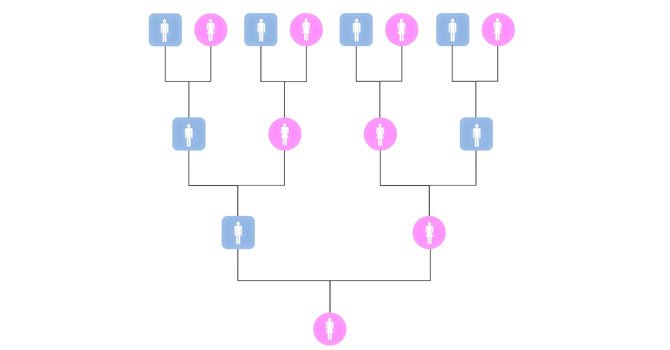
© 2015 50plus Senior News, All rights reserved.
The Search for Our Ancestry: Are You My Cousin?
Angelo Coniglio | Jan 12, 2015, 6 a.m.

After having my DNA tested by 23andMe, registering with the site online, and seeing preliminary results, I invited certain of the other participants to share their genomes (genetic “blueprints”) with me.
My selection of those I invited was based on several factors:
- Were the person’s haplogroup codes similar to mine, indicating common ancestors in the distant past?
- Was the person’s surname, or the surnames listed in his/her profile, familiar, possibly matching surnames in my direct ancestry?
- Were the ancestral towns listed the same as or geographically near to mine?
- How close was the indicated relationship?
That last criterion bears deeper consideration. The tests run by 23andMe consider a cumulative length of DNA segments of 7,440 centiMorgans (cM) to represent my total genome.
The combined length of all the matching segments from another person is compared to 7,440, and an approximate percentage of shared DNA is calculated. In theory, then, my child would have a total matching length of 3,720 cM, or 50 percent of my DNA.
To give a feel for the degree of relationships found for me so far, one of the “closest” relatives found has a total of 36 cM in two segments, for a shared DNA percentage of 0.48 percent. That’s less than one-half of 1 percent! But according to 23andMe, this person is my “third to fifth cousin.”
These numbers may seem miniscule, but consider the following: 50 percent of my DNA should come from my father, 25 percent from my grandfather, 12.5 percent from my great-grandfather, and so on. By the time I’ve counted back seven generations, I have less than 1 percent of my great-great-great-great-great-grandfather’s DNA.
Because of changes in DNA over the generations due to random mutations, the actual percentage retained from each ancestor is less than the theoretical amount. So 0.48 percent shared DNA, from my example above, can mean a relationship as close as “third to fifth cousin.”
Earlier, I pointed out that many who have their DNA tested are reluctant to share their names or their ancestors’ surnames and ancestral towns.
There are generally two reasons for this. Folks are concerned about privacy and possible identity theft; and those who have developed their own paper family trees often show a reluctance to make those trees available to others because of pride of ownership.
In my view, those who have such concerns shouldn’t bother having their DNA tested, since those positions effectively suppress any interaction with potential relatives.
Generally, I chose to invite (for genome comparison) folks who shared ancestral surnames and/or places of origin. My reason is that I feel those people have the greatest chance of having developed a paper genealogy that somewhere meshes with my own, and in that way I hope to find names, dates, and records that I have not yet included in my family tree.
For example: My earliest known Coniglio relative is my fourth-great-grandfather Filippo, who (from a son’s marriage record) died after Jan. 7, 1770, and was probably born around 1715. I know his wife’s name, Vincenza Ricotta, and the names of five sons: Pasquale, Gaspare, Angelo, Amadeo, and Felice—all from Serradifalco, Sicily.
Let’s say I find a person, call him Joe, with a very small percentage of matching DNA but who shows an ancestral town of Serradifalco, with ancestors surnamed Coniglio.
I contact Joe, we share genomes, and in correspondence he tells me he’s the descendant of Giuseppe Coniglio, born in 1740, son of Filippo Coniglio and Vincenza Ricotta. He has their baptism and marriage records and has found that Filippo’s father was Pasquale Coniglio, born in Serradifalco in 1680.
So, by having my DNA tested and comparing it to a distant relative who had his tested, after inspection of sources and corroboration, I’ve found an extension of my own family tree and the name of my fifth-great-grandfather.
DNA testing didn’t extend my “tree,” but it gave me the means to do so.
|
Write to Angelo at genealogytips@aol.com or visit his
website, www.bit.ly/AFCGen.
He is the author of the book The Lady of the Wheel (La Ruotaia), based on his genealogical research of Sicilian foundlings. For more information, see www.bit.ly/SicilianStory. |





